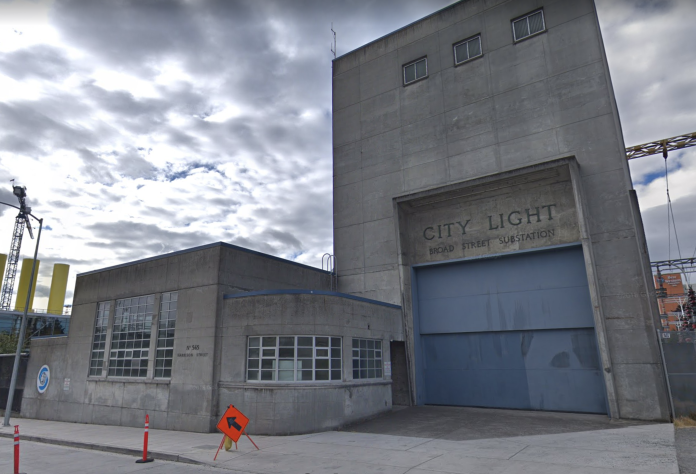On Monday, the Seattle City Council officially designated a new landmark. Known as the Broad Street Substation, the property and building provide valuable electrical service to the burgeoning districts in Uptown, Belltown, and South Lake Union. The site was progressively developed between 1949 and 1951 in a style reminiscent of the Works Progress Administration era.

The substation is located near the new SR-99 portal between Harrison Street, Taylor Ave N, Thomas Street, and 6th Ave N. The most prominent facade is located on Harrison Street with a towering entrance emblazoned with “City Light”, which operates the facility. Several key structures will have preservation controls that protect the unique building exteriors, including the Crane Building on Harrison Street and the Control Building on 6th Ave N.
The Seattle City Council also introduced and referred new land use legislation addressing electric vehicle-ready (EV) charging systems in new development to the Transportation and Sustainability Committee. Mayor Jenny Durkan recently highlighted the legislation in the State of the City Address. “We want to reduce reliance on cars as much as possible and we will continue to develop plans to reduce congestion, and make our downtown core a healthier place for all,” she said. “But we also want to replace carbon and move aggressively to electric cars and buses.”
“This week, I will send legislation to the City Council to require all new buildings in Seattle to provide charging infrastructure for electric vehicles,” Mayor Durkan added. “If we are going to have more electric cars in Seattle–and reduce our climate pollution–then we need accessible, and equitably available electric charging.”
In this context, EV-ready means providing parking spaces that are “designed and constructed to include a fully-wired circuit with a 208/240-volt, 40-amp electric vehicle charging receptacle outlet or termination point.” That includes installation of conduit, wiring, and electrical capacity that could facilitate an EV charging equipment if and when it is installed in the future.

The legislation is fairly straightforward and would require the following:
- Individual residences. At least one EV-ready space for individual residences (e.g., single-family detached, duplex, or townhouse) with private garages, carports, or parking areas.
- Multiple residences. Generally, at least 20% of all shared parking spaces in garages or surface parking lots in multifamily developments would need to be EV-ready, except that in the case of surface parking lots with between one and six parking spaces, all spaces would need to be EV-ready, and surface parking lots between seven and 25 parking spaces would need to have at least six EV-ready spaces.
- Other residential uses. All other residential uses with parking would need to be provided with at least 20% of parking spaces as EV-ready.
- Non-residential uses. At least 10% of all parking spaces for non-residential uses would need to be EV-ready.
If no parking is provided as part of a development, then EV-ready requirements would not apply. The legislation also provides clarity on how rounding of EV-ready parking space requirements operate and discretionary reductions of requirements. Implementation of the requirements will rely upon the Seattle Electrical Code, which already has some standards for EV-charging equipment.
Stephen is a professional urban planner in Puget Sound with a passion for sustainable, livable, and diverse cities. He is especially interested in how policies, regulations, and programs can promote positive outcomes for communities. With stints in great cities like Bellingham and Cork, Stephen currently lives in Seattle. He primarily covers land use and transportation issues and has been with The Urbanist since 2014.



